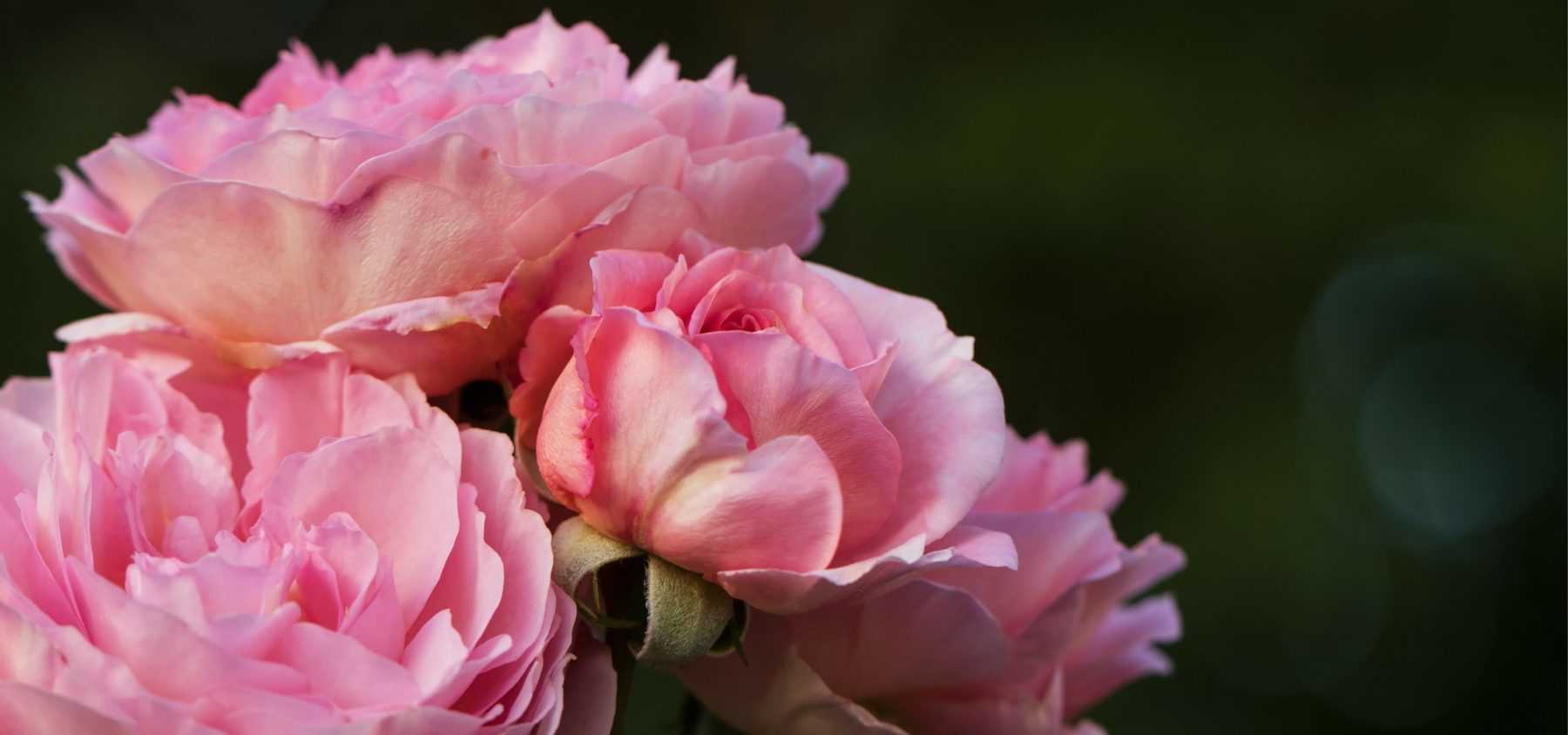
Roses: succeed in planting in pots and in naked roots
Our expert tips for planting your roses
Contents
Symbols of love and romance, we appreciate roses for their very delicate and pleasantly scented flowers, single or double, which come in a wide range of colours. Their planting is an important step that should not be overlooked and is crucial for their flourishing! Indeed, a rose that starts poorly will rarely become a beautiful specimen. A rose in a pot or bare root is not planted in the same way, nor at the same time. Discover our planting guide to install your rose under the best conditions.
When to plant roses?
-
Potted or “Container” Roses
Roses sold in containers allow for an extended availability and establishment period for the plants. You can plant them all year round, provided you remain attentive during the weeks following planting. Indeed, the rooting period for the bush is approximately 8 weeks in spring or autumn, so regular watering is essential. During very hot months, establishment is more delicate; you will need to prune the plants quite short and water more frequently.
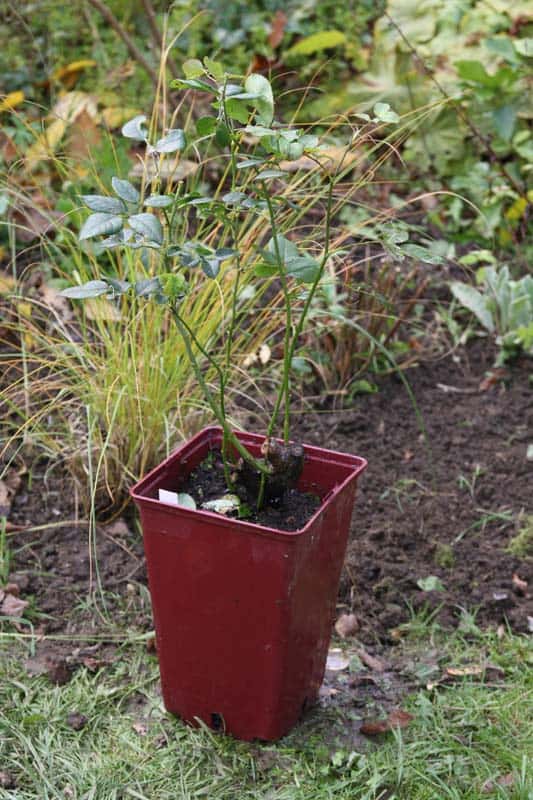 Container Rose
Container Rose
Dug up in October to be available for sale, these roses should be planted from November to the end of March, avoiding frost periods.
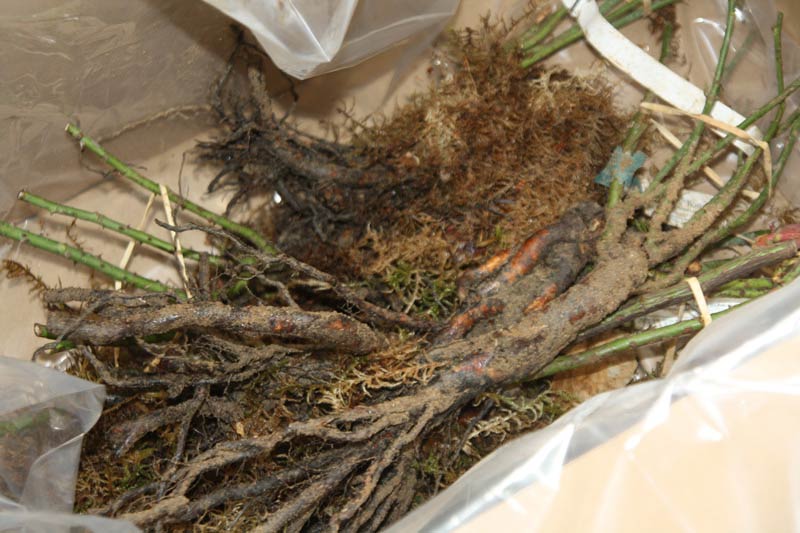 Bare Root Roses
Bare Root Roses
Read also
Propagate roses: when and how?How to prepare the soil for planting a rose bush?
Although roses prefer good garden soil that is slightly clayey, they can adapt to almost any type of soil. However, it is advisable to amend and enrich the soil.
- A sandy and porous ground will be improved by adding organic matter (well-decomposed manure, compost…) which should be thoroughly mixed with the soil.
- In overly heavy soil, drainage must be improved. For while roses need plenty of water, they do not appreciate stagnant moisture that suffocates their roots, nor very compact soils that hinder the development of rootlets. In both cases, it is essential to facilitate water drainage and soil aeration by adding organic matter such as compost, leaf mould, or gravel, and pumice.
What is important for the rose is to have loose, well-aerated soil rich in organic elements, where its young roots can easily find their way. That is why you should mix a good homemade compost or well-decomposed manure into the soil surrounding the roots.
Discover other Roses
View all →Available in 0 sizes
Available in 3 sizes
Available in 0 sizes
Available in 0 sizes
Available in 0 sizes
Available in 0 sizes
Available in 0 sizes
Available in 0 sizes
Available in 4 sizes
Available in 0 sizes
How to plant a rose sold in a container?
Roses sold in plastic containers are not meant to stay as they are! You must absolutely replant them in your garden or in a larger pot.
To plant a rose sold in a container:
- Soak the rose in its pot in a large basin of water until no more bubbles rise to the surface.
- Using a trowel, dig a hole 40 cm long, wide, and deep. Carefully remove the pot to avoid breaking the root ball.
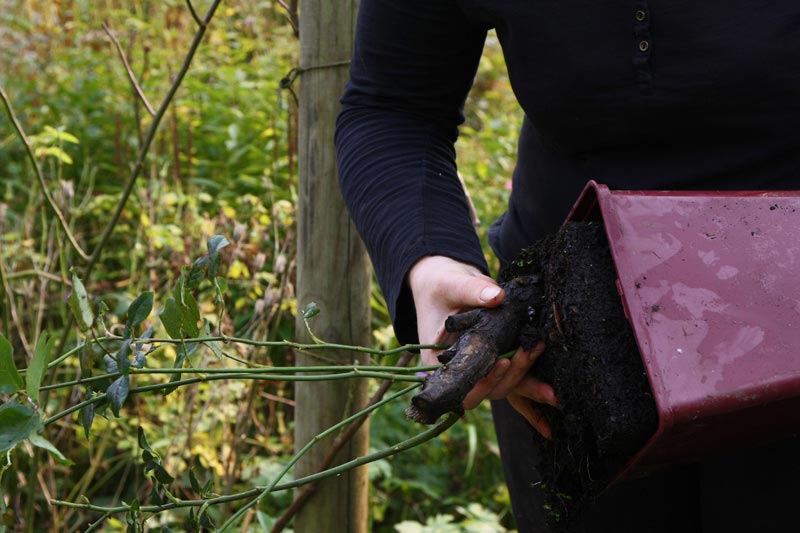
Carefully remove the root ball from its pot.
- Place a stake above the hole to indicate the soil level.
- Position the plant so that the grafting point is slightly above the stake, or plant it so that only 2 to 3 cm of soil is added above the root ball.
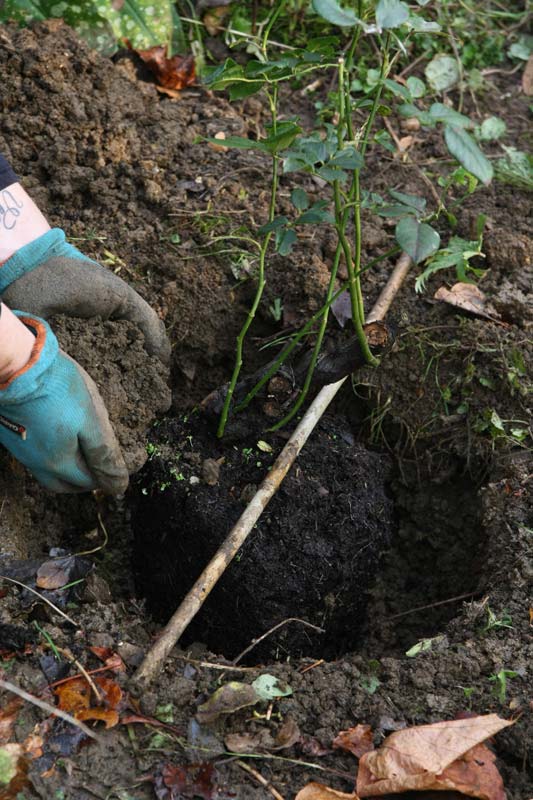
- Backfill and water generously to fill any air pockets.
In dry weather, be sure to water regularly, about one watering can per week, to facilitate rooting.
- Tip
It is possible that roots escape through the drainage holes of your container-grown rose. As it is impossible to remove them without damaging the precious root hairs, cut the container with a pruning shear to preserve as many roots as possible.
How to plant a rose bush with naked roots?
Upon receiving your bare-root roses, fully immerse them in a basin of water to rehydrate the tissues. Ideally, they should be planted on the same day.
It may happen that you receive your roses on a day when it is impossible for you to plant. Don’t panic: you can heel them in while waiting for their permanent planting.
Heeling in: to create a heel, dig a trench 30 cm wide and deep in a shaded, sheltered spot. Place the roses in tightly and slightly angled to reduce wind exposure. Cover them with soil from your garden or potting soil, ensuring that the substrate penetrates between the roots to avoid air pockets. The mix should rise to the grafting points of the roses and be properly compacted. If it doesn’t rain, water the soil a little to maintain good moisture for the roots. They can remain heeled in for 3 to 4 days.
On the big day:
- Start by “dressing” the roots. This operation involves cutting, with clean pruning shears, any roots that may have been damaged during uprooting. These clean cuts facilitate the recovery of the rose.
- Then, if necessary, trim the branches of your rose, knowing that the above-ground part should be equivalent to the below-ground part.
- Mix soil, water, and compost (or well-rotted manure) in a basin to create a thick mud known as “pralin.” To learn all about root pralinage, check our dedicated advice sheet: Pralining the roots of trees and shrubs.
- Soak the rose up to the collar. This operation contributes to the successful recovery of the young plant.
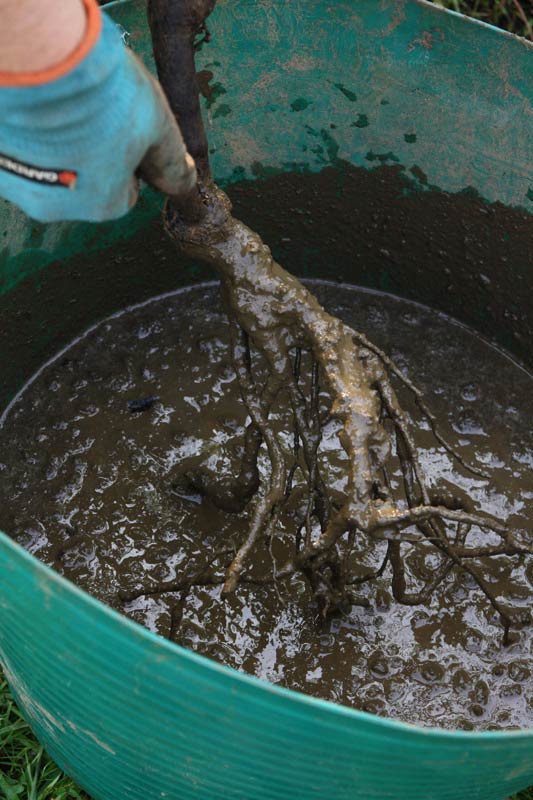
Pralinage is a step not to be overlooked when planting roses.
- With a shovel, make a hole 40 cm wide and deep, breaking up the soil well.
- Add a scoop of good homemade compost or well-rotted manure to the excavated soil and mix. You can also add a bit of ground horn which breaks down slowly (over 2 or 3 years) in the soil and provides an excellent long-term food reserve. It should be buried in good quantity at the time of planting. To learn all about organic fertilisers, check our advice sheet: Ground horn, dried blood, guano… What are they for?
- Place your rose in the hole, ensuring to spread the roots well in the hole. The aim is to prevent them from curling upwards.
- Place a stick above the hole to indicate the soil level.
- Begin to refill the hole with soil while keeping the rose at the correct height, meaning the graft point (bulge) slightly above the stick.
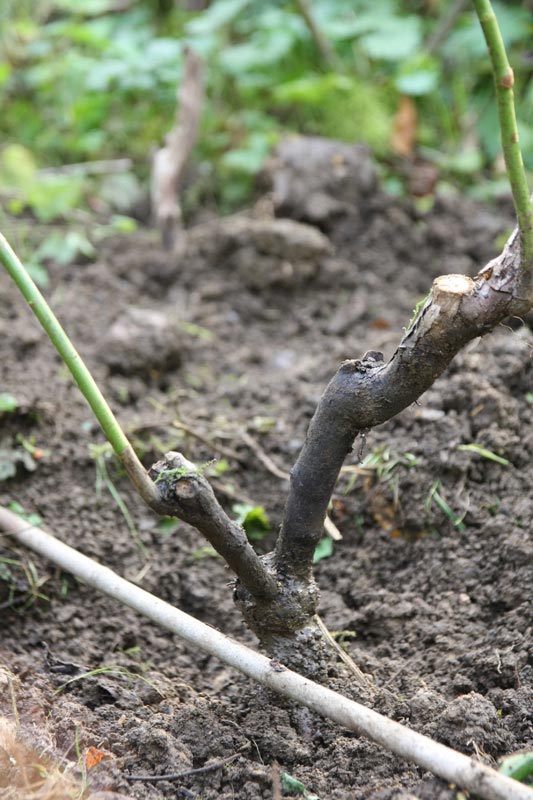
The graft point should be slightly above the soil level.
- Once the roots are covered with soil, firm the soil around the rose with your hands to create a small basin that will retain water. Check the anchorage of the bush by gently pulling on it. It should not move.
- Water generously.
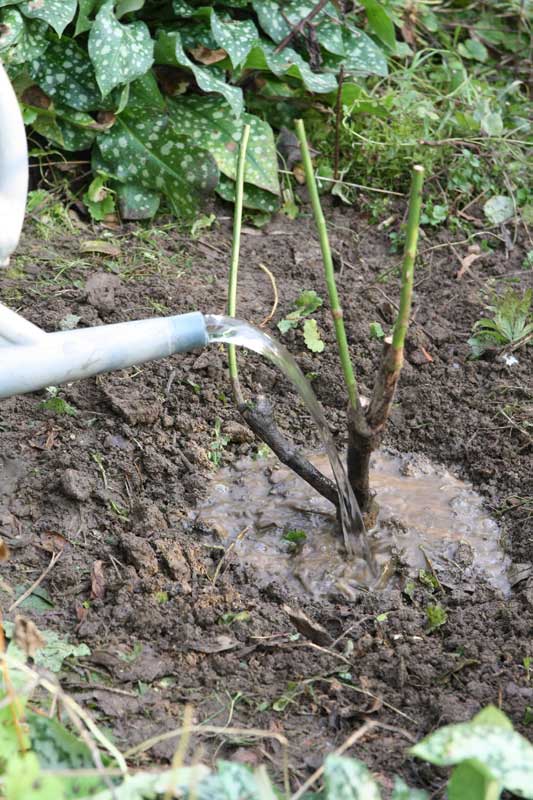
Proper watering helps to eliminate all air bubbles.
- Cover the graft point with a good layer of dead leaves or straw.
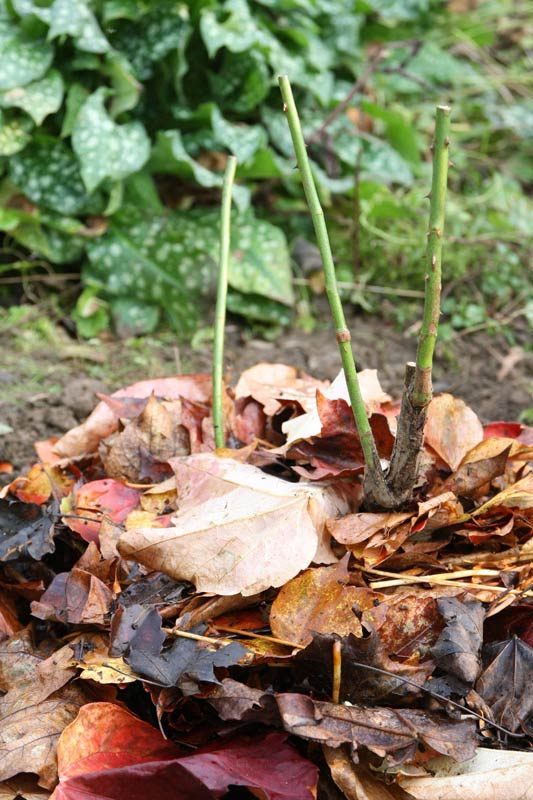 Protecting the graft point with a good layer of leaves.[/caption>
Protecting the graft point with a good layer of leaves.[/caption>
Throughout the first year, it is essential to maintain a light but constant moisture.
How to plant liana roses and standard roses?
Start by probing the soil with a metal rod to locate a spot free of large roots. Be careful not to plant at the base of an evergreen, as the rose would lack light. Proceed with the planting as explained earlier, depending on whether it is a container rose or a bare-root rose. Rambling roses should be positioned between 50 cm and 1 m from their support and will be slightly inclined towards it.
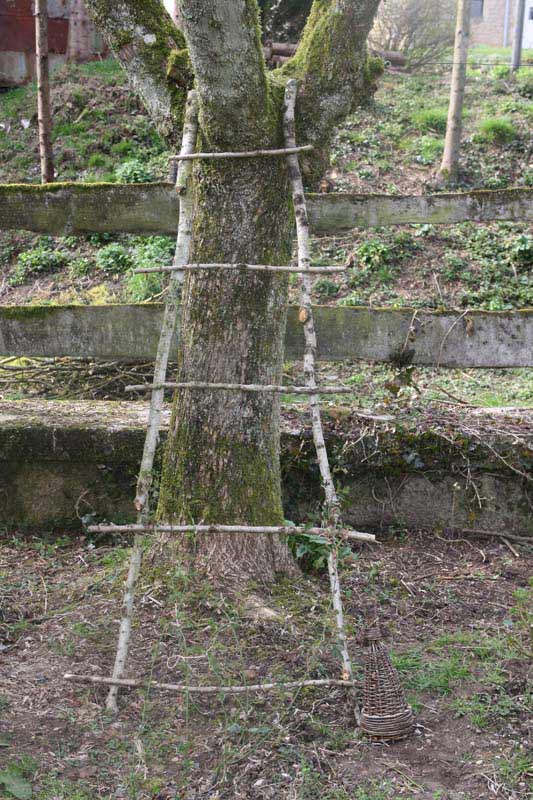
Wooden ladder to guide a liana rose towards the tree.
When planting stem roses, remember to drive a sturdy stake into the bottom of the planting hole. This should be done before placing the rose to avoid damaging the roots. When possible, prefer a bare-root rose to avoid piercing the root ball with the stake. Be careful not to tighten the ties too much to prevent a girdling bulge later on.
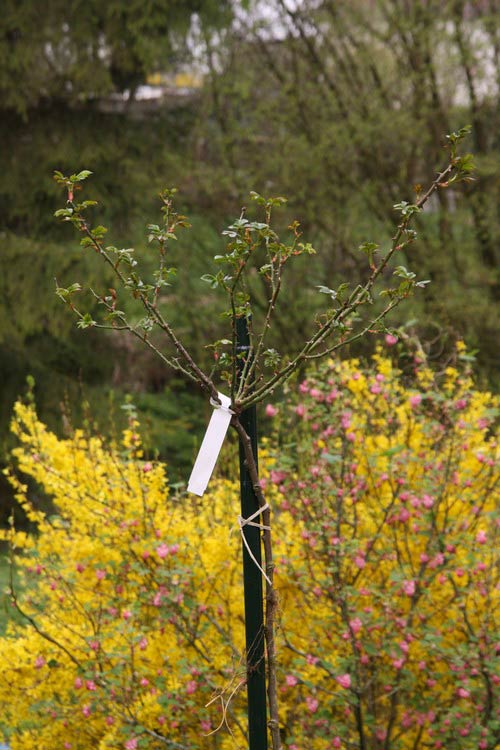 A stake is essential for stem and weeping roses.
A stake is essential for stem and weeping roses.
These roses are varieties grafted onto a stem of variable height, provided by a vigorous “wild” rose, which serves as the rootstock. The grafting point must be protected from frost with winter fleece. You will also need to ensure that all suckers forming on the stem are removed.
How to plant potted roses?
Prefer a sturdy variety with slow growth, better suited for this cultivation, and size the pot according to the development of the young plant. Count on 30 cm in diameter and depth for a miniature rose, 40 cm for a dwarf rose, and 50 cm for a standard bush or a small climber.
This pot should be drilled to allow excess water to drain away. Preferably, choose a terracotta pot, as its porosity is beneficial for the roots. To improve drainage, place 5 cm of gravel, shards, clay balls, or pumice at the bottom of the pot.
To obtain a good substrate, create a mixture composed of:
- 1/3 garden soil (if not available, a good potting mix will suffice)
- 1/3 high-quality potting mix, ideally rose potting mix
- 1/3 well-decomposed compost or manure
Position the young plant in your pot and fill with your mixture to the top of the pot so that the grafting point is level with the surface. Water generously.
Be aware that potted roses require more attention than those in the ground. Regular watering is necessary. However, be careful not to drown your young plant. Finally, the only nourishment the rose will find is what you choose to provide: make regular fertiliser applications during its growing season. Discover when and how to fertilise your roses: Fertilisers for roses.
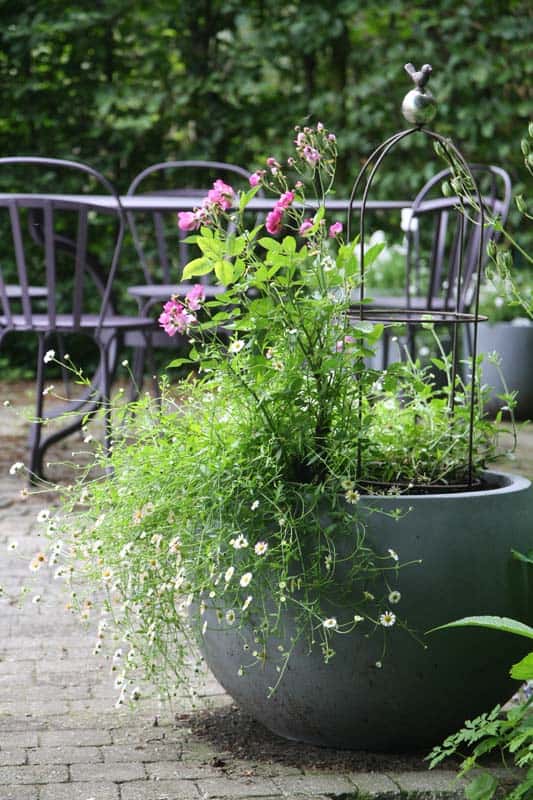
Remove all faded flowers so that the rose does not exhaust itself by forming fruits.
Frequently Asked Questions by Gardeners
- One of my roses has died, and I would like to plant another in the same spot. Is that possible?
Avoid planting a rose in a spot recently occupied by a predecessor. Indeed, many roses release toxins into the soil to deter their kind from their territory. If you have no other choice, we recommend renewing the soil to a width and depth of at least 50 cm.
Virginie’s advice: I have tested it myself, adding mycorrhizae also helps with recovery.
- I have heard that when planting, I should bury the grafting point of my rose.
The question of whether to bury the grafting point or not is a contentious issue. In the past, specialists recommended positioning the grafting point slightly above the soil. Today, they increasingly advocate burying it to prevent the development of latent buds and the appearance of suckers on the rootstock. When the rootstock is buried in this way, it sometimes happens that the grafted subject develops its own roots. Some consider this nonsensical, as this practice removes the utility of the rootstock, which is meant to act as an intermediary between the soil and the subject, thus allowing for better adaptation of one to the other. This argument seems perfectly valid, especially in cases where the soil is poor for roses, such as very chalky soil. In this case, only the use of an appropriate rootstock allows for the cultivation of roses under good conditions. Furthermore, there are many varieties whose vigour is insufficient to allow them to do without the sap provided by the rootstock. However, when one has good rose soil, there may be an advantage to leaving the subject on its own roots. This way, suckers are avoided, and the longevity of the bushes is considerably increased. Some rose growers therefore recommend burying the grafting point by 5 to 10 cm. In regions that experience severe frosts, the grafting point is buried, a precaution that helps to better protect against frost.
- Subscribe!
- Contents



































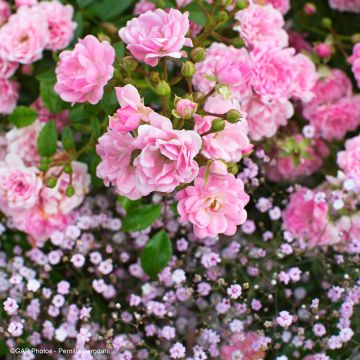
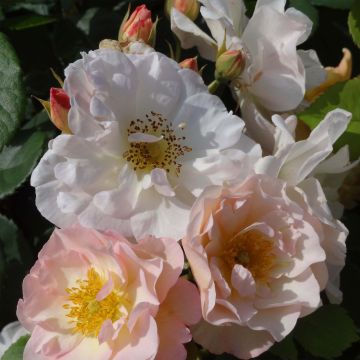


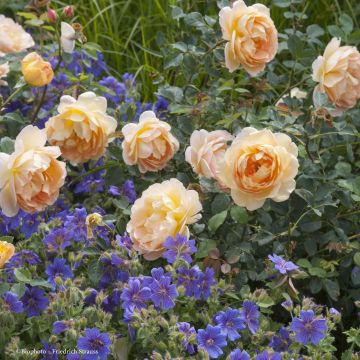





Comments